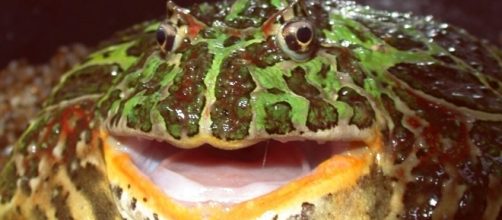Extinct giant frogs lived in Madagascar 68 million years ago. With heads measuring about 6 inches across (154 millimeters), the jaws of these Beelzebufo ampinga giant frogs, sometimes called "devil frogs," exerted a bite force up to 25 percent greater than living frogs of subtropical and tropical South America. These living frogs measure a jaw force of 500 Newtons (N). Giant Frogs Of Madagascar, weighing 10 pounds and long extinct, had a jaw power of 2,200 Newtons.
Large present-day frogs feast on snakes and rodents
The large horned frogs found today in warm South American forests — with a bite force less than that of their extinct cousins Beelzebufo ampinga — eat small reptiles and rodents, according to the study's co-author Marc Jones of the University of Adelaide and the South Australian Museum.
With a force of 500 N, this frog's bite would feel like "'50 liters of water'" if you balanced it on a fingertip. This is how it was described by lead author Kristopher Lappin, professor of biological sciences at California State Polytechnic University, Pomona (Cal Poly Pomona).
Madagascar frogs feasting on small and juvenile dinosaurs?
Beelzebufo ampinga, with a calculated maximum force of 2,200 N, would have had a bite force that could be compared to wolves or tigers. Madagascar's devil frogs would indeed have been capable of feasting on small and juvenile dinosaurs.
The authors noted in their study, published in Scientific Reports, that their calculation "may be less than the maximum possible" for the Madagascar frog because "some fossil material" studied had "unfused cranial sutures" indicative of a juvenile, not an adult.
Their suggestion is that a mature adult would have a force greater than that of a juvenile.
Giant frog scaling experiment
An international team of researchers conducted a first-time bite force scaling experiment to determine what the force of Madagascar's extinct giant frog's bite would have been. Scientists measured the head width and the length of Ceratophrys, which are small and large horned frogs found in the U.S. and the U.K. and in South America, respectively. The results were compared to the head measurements of Madagascar's Beelzebufo ampinga to determine comparative bite force. This is a scaling method used previously for fish, lizards, alligators, and rodents. The study concluded that the "Bite force in the horned frog (Ceratophrys cranwelli) were indicators of the extinct giant frogs."


